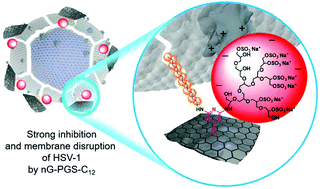Functionalized nanographene sheets with high antiviral activity through synergistic electrostatic and hydrophobic interactions†
Abstract
As resistance to traditional drugs emerges for treatment of virus infections, the need for new methods for virus inhibition increases. Graphene derivatives with large surface areas have shown strong activity against different viruses. However, the inability of current synthetic protocols to accurately manipulate the structure of graphene sheets in order to control their antiviral activity remains a major challenge. In this work, a series of graphene derivatives with defined polyglycerol sulfate and fatty amine functionalities have been synthesized and their interactions with herpes simplex virus type 1 (HSV-1) are investigated. While electrostatic interactions between polyglycerol sulfate and virus particles trigger the binding of graphene to virus, alkyl chains induce a high antiviral activity by secondary hydrophobic interactions. Among graphene sheets with a broad range of alkyl chains, (C3–C18), the C12-functionalized sheets showed the highest antiviral activity, indicating the optimum synergistic effect between electrostatic and hydrophobic interactions, but this derivative was toxic against the Vero cell line. In contrast, sheets functionalized with C6- and C9-alkyl chains showed low toxicity against Vero cells and a synergistic inhibition of HSV-1. This study shows that antiviral agents against HSV-1 can be obtained by controlled and stepwise functionalization of graphene sheets and may be developed into antiviral agents for future biomedical applications.



 Please wait while we load your content...
Please wait while we load your content...